Executive Summary Report: High Performance Workplace Analysis
VerifiedAdded on 2020/03/01
|19
|4197
|17
Report
AI Summary
This report provides an executive summary focusing on high-performance workplaces (HPW) and high-performance workplace organizations (HPWO), emphasizing their role in sustaining long-term organizational performance. It delves into the key components of HPW, including managerial commitment, flexibility, employee engagement, and organizational culture. The report also examines performance management systems, outlining the performance management cycle and the importance of development and performance reviews. Furthermore, it discusses the creation and maintenance of a high-performance culture, offering recommendations for building trust, enthusiasm, and commitment among employees and leaders. The report highlights the link between HPW and sustained organizational performance, employee well-being, and competitive advantage, while also identifying barriers to HPW implementation. The report covers the main stages of the performance management cycle, including setting organizational goals, communicating goals, observing performance and providing feedback, and evaluating performance. Finally, it explores the crucial role of leaders in fostering effective communication and driving organizational success.
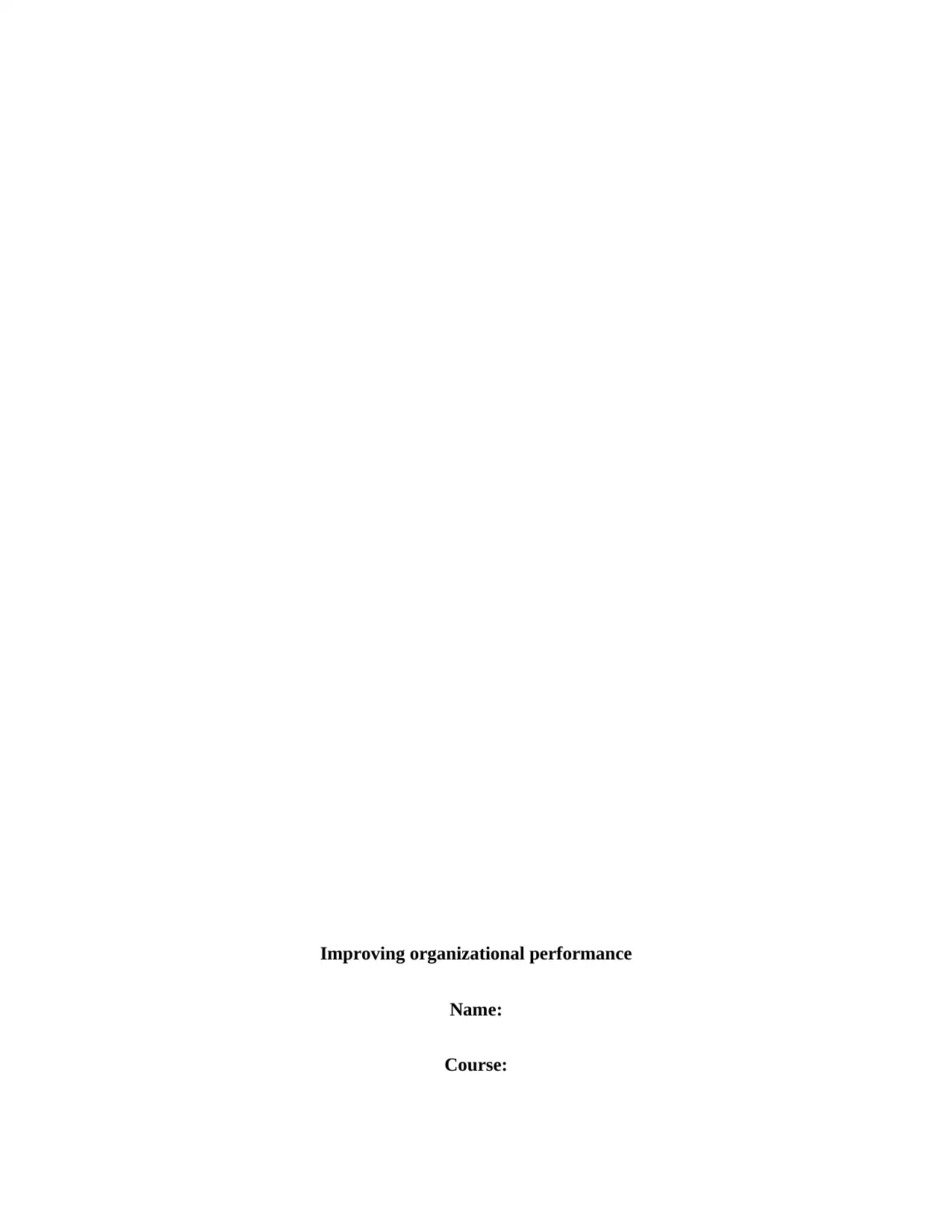
Improving organizational performance
Name:
Course:
Name:
Course:
Paraphrase This Document
Need a fresh take? Get an instant paraphrase of this document with our AI Paraphraser
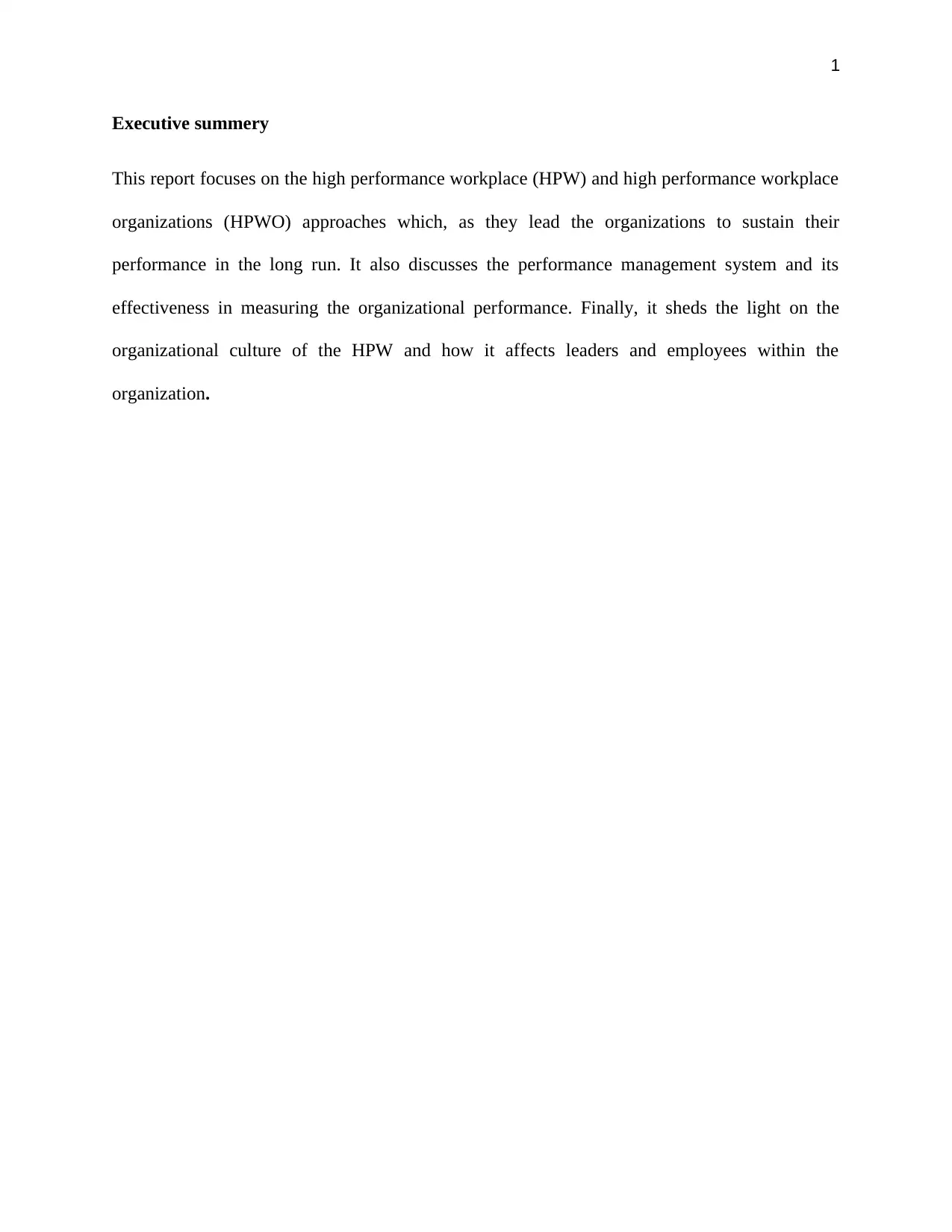
1
Executive summery
This report focuses on the high performance workplace (HPW) and high performance workplace
organizations (HPWO) approaches which, as they lead the organizations to sustain their
performance in the long run. It also discusses the performance management system and its
effectiveness in measuring the organizational performance. Finally, it sheds the light on the
organizational culture of the HPW and how it affects leaders and employees within the
organization.
Executive summery
This report focuses on the high performance workplace (HPW) and high performance workplace
organizations (HPWO) approaches which, as they lead the organizations to sustain their
performance in the long run. It also discusses the performance management system and its
effectiveness in measuring the organizational performance. Finally, it sheds the light on the
organizational culture of the HPW and how it affects leaders and employees within the
organization.
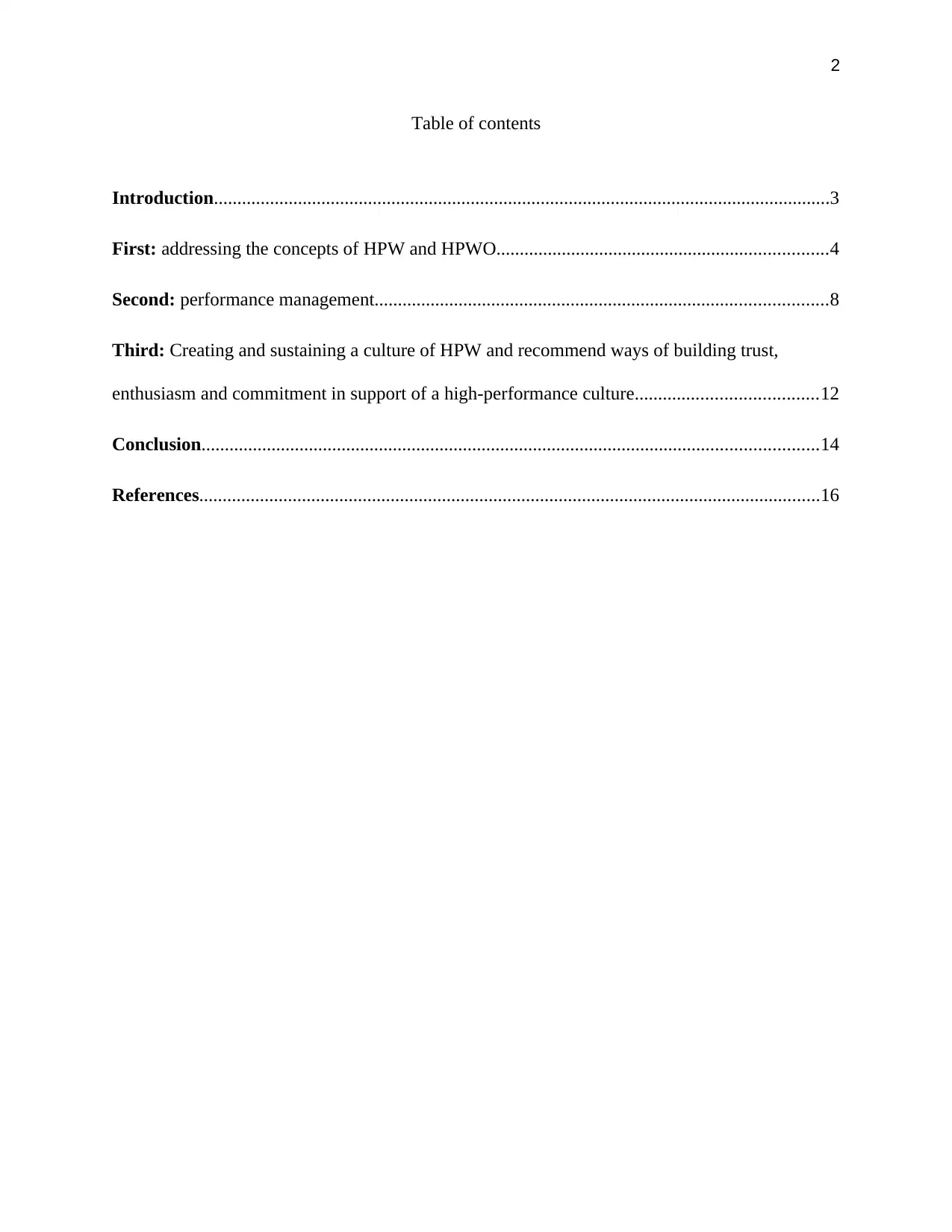
2
Table of contents
Introduction....................................................................................................................................3
First: addressing the concepts of HPW and HPWO.......................................................................4
Second: performance management.................................................................................................8
Third: Creating and sustaining a culture of HPW and recommend ways of building trust,
enthusiasm and commitment in support of a high-performance culture.......................................12
Conclusion....................................................................................................................................14
References.....................................................................................................................................16
Table of contents
Introduction....................................................................................................................................3
First: addressing the concepts of HPW and HPWO.......................................................................4
Second: performance management.................................................................................................8
Third: Creating and sustaining a culture of HPW and recommend ways of building trust,
enthusiasm and commitment in support of a high-performance culture.......................................12
Conclusion....................................................................................................................................14
References.....................................................................................................................................16
⊘ This is a preview!⊘
Do you want full access?
Subscribe today to unlock all pages.

Trusted by 1+ million students worldwide
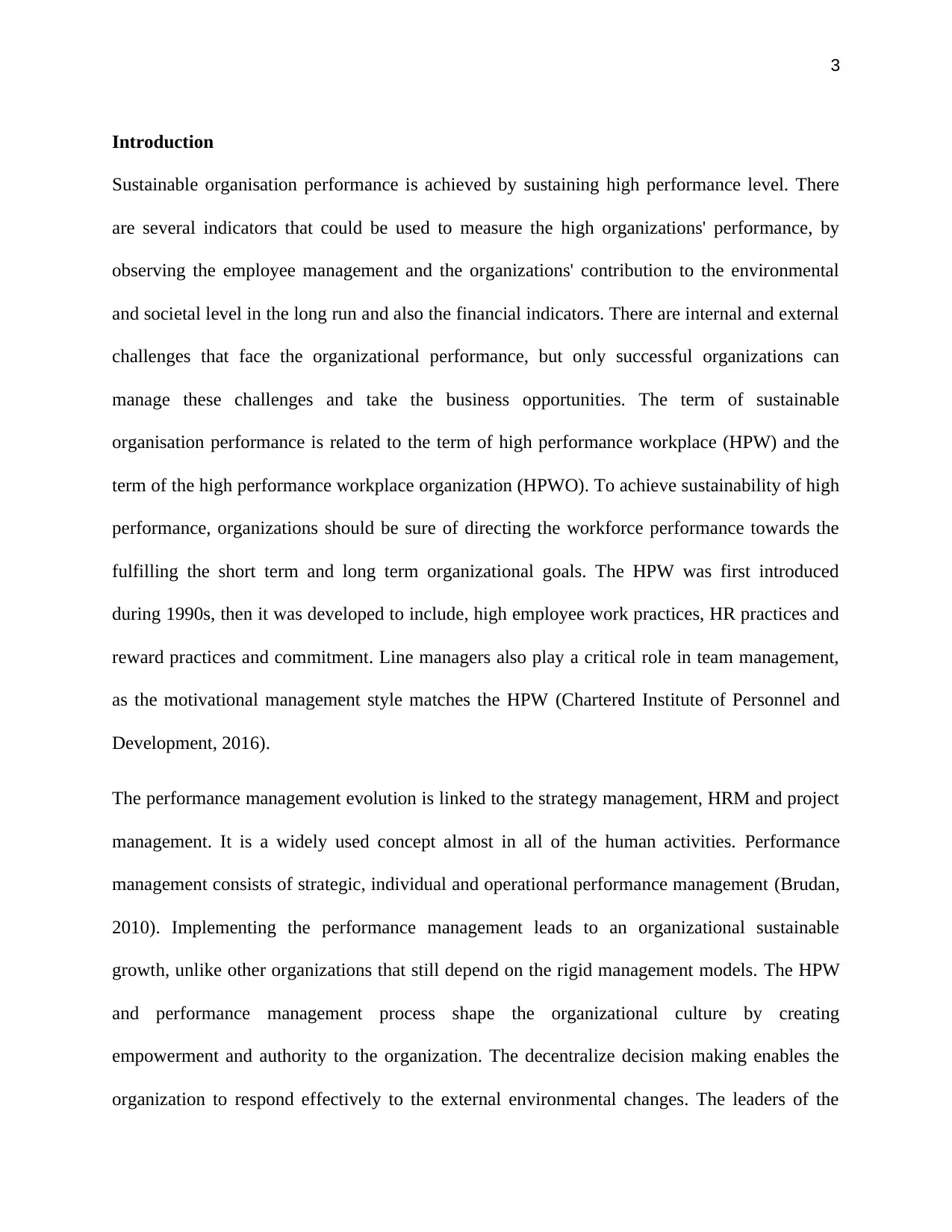
3
Introduction
Sustainable organisation performance is achieved by sustaining high performance level. There
are several indicators that could be used to measure the high organizations' performance, by
observing the employee management and the organizations' contribution to the environmental
and societal level in the long run and also the financial indicators. There are internal and external
challenges that face the organizational performance, but only successful organizations can
manage these challenges and take the business opportunities. The term of sustainable
organisation performance is related to the term of high performance workplace (HPW) and the
term of the high performance workplace organization (HPWO). To achieve sustainability of high
performance, organizations should be sure of directing the workforce performance towards the
fulfilling the short term and long term organizational goals. The HPW was first introduced
during 1990s, then it was developed to include, high employee work practices, HR practices and
reward practices and commitment. Line managers also play a critical role in team management,
as the motivational management style matches the HPW (Chartered Institute of Personnel and
Development, 2016).
The performance management evolution is linked to the strategy management, HRM and project
management. It is a widely used concept almost in all of the human activities. Performance
management consists of strategic, individual and operational performance management (Brudan,
2010). Implementing the performance management leads to an organizational sustainable
growth, unlike other organizations that still depend on the rigid management models. The HPW
and performance management process shape the organizational culture by creating
empowerment and authority to the organization. The decentralize decision making enables the
organization to respond effectively to the external environmental changes. The leaders of the
Introduction
Sustainable organisation performance is achieved by sustaining high performance level. There
are several indicators that could be used to measure the high organizations' performance, by
observing the employee management and the organizations' contribution to the environmental
and societal level in the long run and also the financial indicators. There are internal and external
challenges that face the organizational performance, but only successful organizations can
manage these challenges and take the business opportunities. The term of sustainable
organisation performance is related to the term of high performance workplace (HPW) and the
term of the high performance workplace organization (HPWO). To achieve sustainability of high
performance, organizations should be sure of directing the workforce performance towards the
fulfilling the short term and long term organizational goals. The HPW was first introduced
during 1990s, then it was developed to include, high employee work practices, HR practices and
reward practices and commitment. Line managers also play a critical role in team management,
as the motivational management style matches the HPW (Chartered Institute of Personnel and
Development, 2016).
The performance management evolution is linked to the strategy management, HRM and project
management. It is a widely used concept almost in all of the human activities. Performance
management consists of strategic, individual and operational performance management (Brudan,
2010). Implementing the performance management leads to an organizational sustainable
growth, unlike other organizations that still depend on the rigid management models. The HPW
and performance management process shape the organizational culture by creating
empowerment and authority to the organization. The decentralize decision making enables the
organization to respond effectively to the external environmental changes. The leaders of the
Paraphrase This Document
Need a fresh take? Get an instant paraphrase of this document with our AI Paraphraser
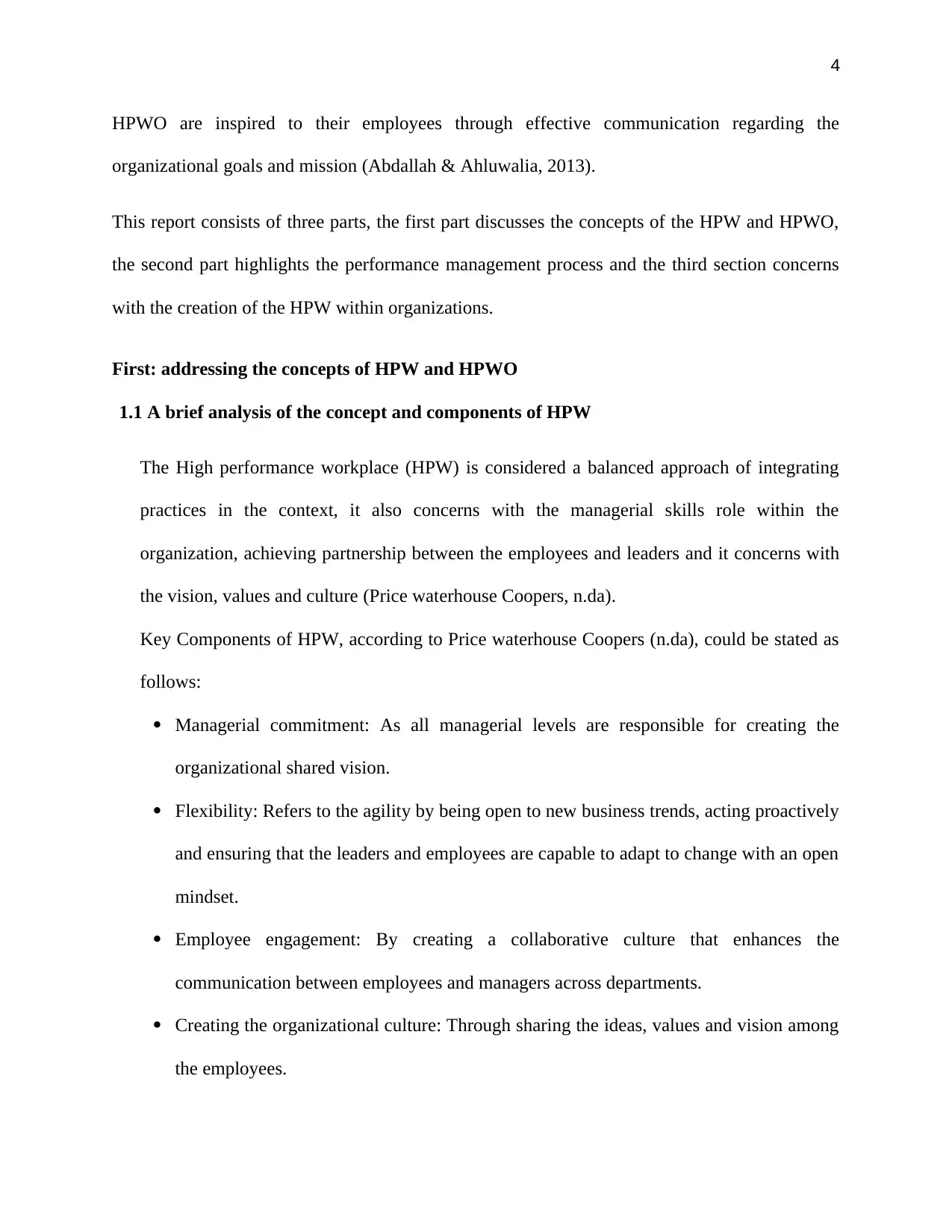
4
HPWO are inspired to their employees through effective communication regarding the
organizational goals and mission (Abdallah & Ahluwalia, 2013).
This report consists of three parts, the first part discusses the concepts of the HPW and HPWO,
the second part highlights the performance management process and the third section concerns
with the creation of the HPW within organizations.
First: addressing the concepts of HPW and HPWO
1.1 A brief analysis of the concept and components of HPW
The High performance workplace (HPW) is considered a balanced approach of integrating
practices in the context, it also concerns with the managerial skills role within the
organization, achieving partnership between the employees and leaders and it concerns with
the vision, values and culture (Price waterhouse Coopers, n.da).
Key Components of HPW, according to Price waterhouse Coopers (n.da), could be stated as
follows:
Managerial commitment: As all managerial levels are responsible for creating the
organizational shared vision.
Flexibility: Refers to the agility by being open to new business trends, acting proactively
and ensuring that the leaders and employees are capable to adapt to change with an open
mindset.
Employee engagement: By creating a collaborative culture that enhances the
communication between employees and managers across departments.
Creating the organizational culture: Through sharing the ideas, values and vision among
the employees.
HPWO are inspired to their employees through effective communication regarding the
organizational goals and mission (Abdallah & Ahluwalia, 2013).
This report consists of three parts, the first part discusses the concepts of the HPW and HPWO,
the second part highlights the performance management process and the third section concerns
with the creation of the HPW within organizations.
First: addressing the concepts of HPW and HPWO
1.1 A brief analysis of the concept and components of HPW
The High performance workplace (HPW) is considered a balanced approach of integrating
practices in the context, it also concerns with the managerial skills role within the
organization, achieving partnership between the employees and leaders and it concerns with
the vision, values and culture (Price waterhouse Coopers, n.da).
Key Components of HPW, according to Price waterhouse Coopers (n.da), could be stated as
follows:
Managerial commitment: As all managerial levels are responsible for creating the
organizational shared vision.
Flexibility: Refers to the agility by being open to new business trends, acting proactively
and ensuring that the leaders and employees are capable to adapt to change with an open
mindset.
Employee engagement: By creating a collaborative culture that enhances the
communication between employees and managers across departments.
Creating the organizational culture: Through sharing the ideas, values and vision among
the employees.
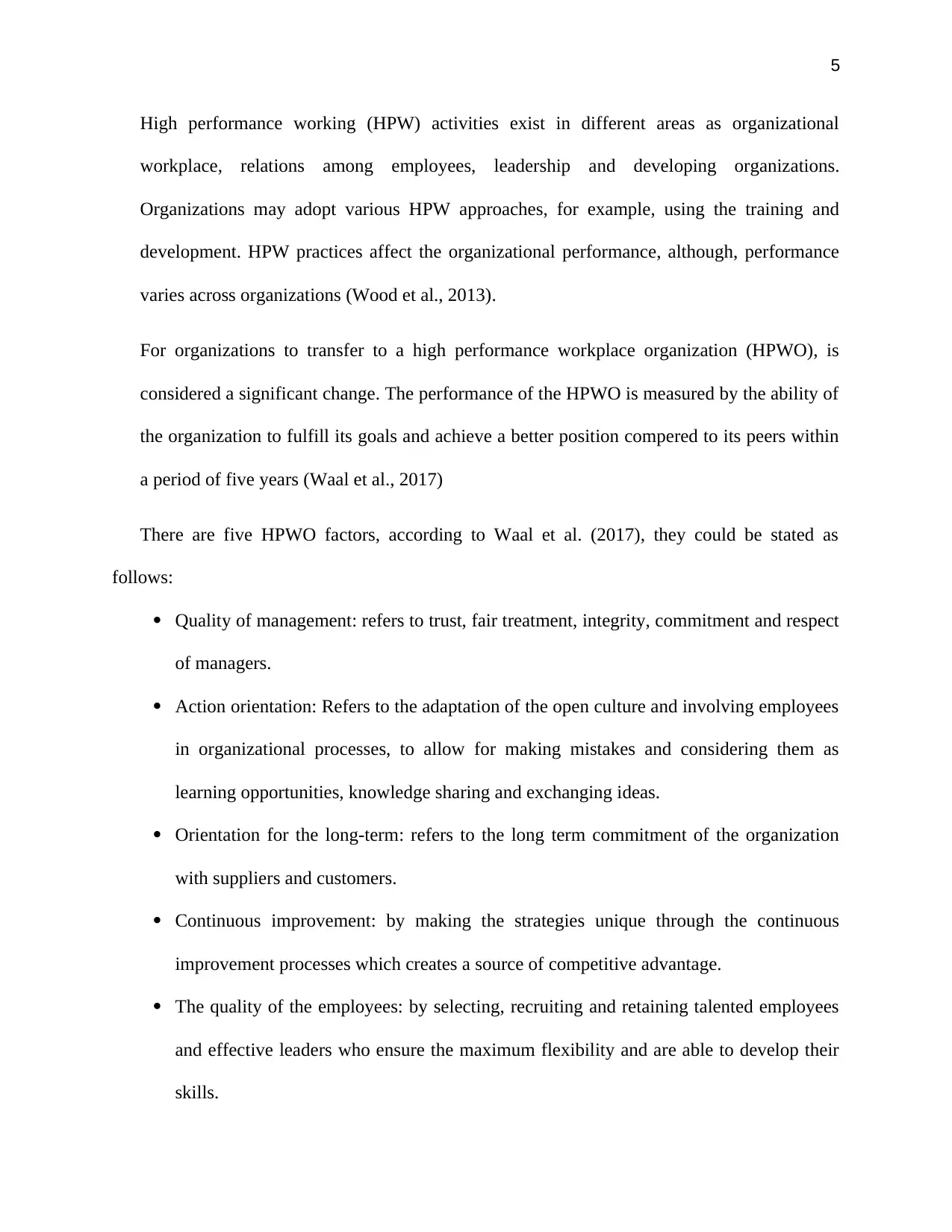
5
High performance working (HPW) activities exist in different areas as organizational
workplace, relations among employees, leadership and developing organizations.
Organizations may adopt various HPW approaches, for example, using the training and
development. HPW practices affect the organizational performance, although, performance
varies across organizations (Wood et al., 2013).
For organizations to transfer to a high performance workplace organization (HPWO), is
considered a significant change. The performance of the HPWO is measured by the ability of
the organization to fulfill its goals and achieve a better position compered to its peers within
a period of five years (Waal et al., 2017)
There are five HPWO factors, according to Waal et al. (2017), they could be stated as
follows:
Quality of management: refers to trust, fair treatment, integrity, commitment and respect
of managers.
Action orientation: Refers to the adaptation of the open culture and involving employees
in organizational processes, to allow for making mistakes and considering them as
learning opportunities, knowledge sharing and exchanging ideas.
Orientation for the long-term: refers to the long term commitment of the organization
with suppliers and customers.
Continuous improvement: by making the strategies unique through the continuous
improvement processes which creates a source of competitive advantage.
The quality of the employees: by selecting, recruiting and retaining talented employees
and effective leaders who ensure the maximum flexibility and are able to develop their
skills.
High performance working (HPW) activities exist in different areas as organizational
workplace, relations among employees, leadership and developing organizations.
Organizations may adopt various HPW approaches, for example, using the training and
development. HPW practices affect the organizational performance, although, performance
varies across organizations (Wood et al., 2013).
For organizations to transfer to a high performance workplace organization (HPWO), is
considered a significant change. The performance of the HPWO is measured by the ability of
the organization to fulfill its goals and achieve a better position compered to its peers within
a period of five years (Waal et al., 2017)
There are five HPWO factors, according to Waal et al. (2017), they could be stated as
follows:
Quality of management: refers to trust, fair treatment, integrity, commitment and respect
of managers.
Action orientation: Refers to the adaptation of the open culture and involving employees
in organizational processes, to allow for making mistakes and considering them as
learning opportunities, knowledge sharing and exchanging ideas.
Orientation for the long-term: refers to the long term commitment of the organization
with suppliers and customers.
Continuous improvement: by making the strategies unique through the continuous
improvement processes which creates a source of competitive advantage.
The quality of the employees: by selecting, recruiting and retaining talented employees
and effective leaders who ensure the maximum flexibility and are able to develop their
skills.
⊘ This is a preview!⊘
Do you want full access?
Subscribe today to unlock all pages.

Trusted by 1+ million students worldwide
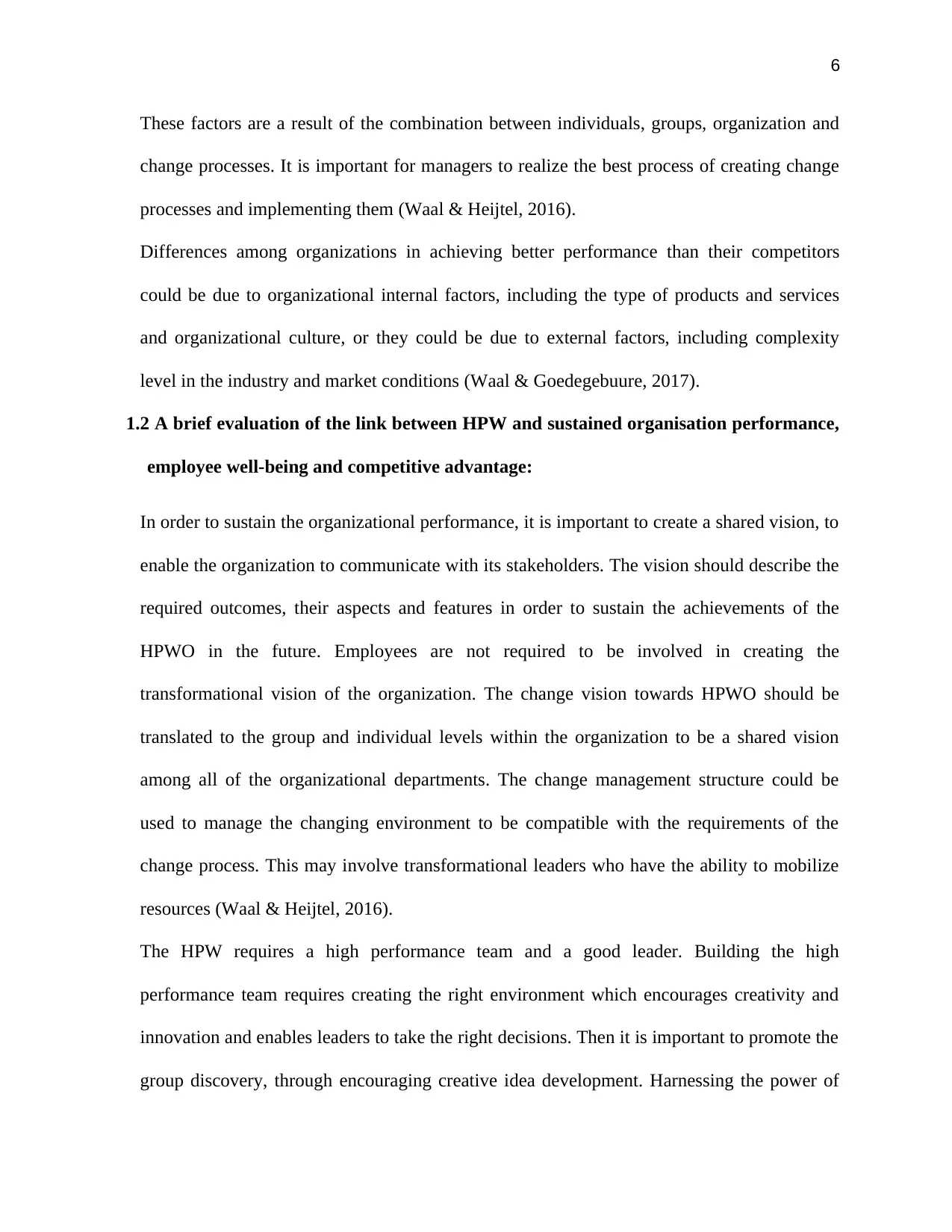
6
These factors are a result of the combination between individuals, groups, organization and
change processes. It is important for managers to realize the best process of creating change
processes and implementing them (Waal & Heijtel, 2016).
Differences among organizations in achieving better performance than their competitors
could be due to organizational internal factors, including the type of products and services
and organizational culture, or they could be due to external factors, including complexity
level in the industry and market conditions (Waal & Goedegebuure, 2017).
1.2 A brief evaluation of the link between HPW and sustained organisation performance,
employee well-being and competitive advantage:
In order to sustain the organizational performance, it is important to create a shared vision, to
enable the organization to communicate with its stakeholders. The vision should describe the
required outcomes, their aspects and features in order to sustain the achievements of the
HPWO in the future. Employees are not required to be involved in creating the
transformational vision of the organization. The change vision towards HPWO should be
translated to the group and individual levels within the organization to be a shared vision
among all of the organizational departments. The change management structure could be
used to manage the changing environment to be compatible with the requirements of the
change process. This may involve transformational leaders who have the ability to mobilize
resources (Waal & Heijtel, 2016).
The HPW requires a high performance team and a good leader. Building the high
performance team requires creating the right environment which encourages creativity and
innovation and enables leaders to take the right decisions. Then it is important to promote the
group discovery, through encouraging creative idea development. Harnessing the power of
These factors are a result of the combination between individuals, groups, organization and
change processes. It is important for managers to realize the best process of creating change
processes and implementing them (Waal & Heijtel, 2016).
Differences among organizations in achieving better performance than their competitors
could be due to organizational internal factors, including the type of products and services
and organizational culture, or they could be due to external factors, including complexity
level in the industry and market conditions (Waal & Goedegebuure, 2017).
1.2 A brief evaluation of the link between HPW and sustained organisation performance,
employee well-being and competitive advantage:
In order to sustain the organizational performance, it is important to create a shared vision, to
enable the organization to communicate with its stakeholders. The vision should describe the
required outcomes, their aspects and features in order to sustain the achievements of the
HPWO in the future. Employees are not required to be involved in creating the
transformational vision of the organization. The change vision towards HPWO should be
translated to the group and individual levels within the organization to be a shared vision
among all of the organizational departments. The change management structure could be
used to manage the changing environment to be compatible with the requirements of the
change process. This may involve transformational leaders who have the ability to mobilize
resources (Waal & Heijtel, 2016).
The HPW requires a high performance team and a good leader. Building the high
performance team requires creating the right environment which encourages creativity and
innovation and enables leaders to take the right decisions. Then it is important to promote the
group discovery, through encouraging creative idea development. Harnessing the power of
Paraphrase This Document
Need a fresh take? Get an instant paraphrase of this document with our AI Paraphraser
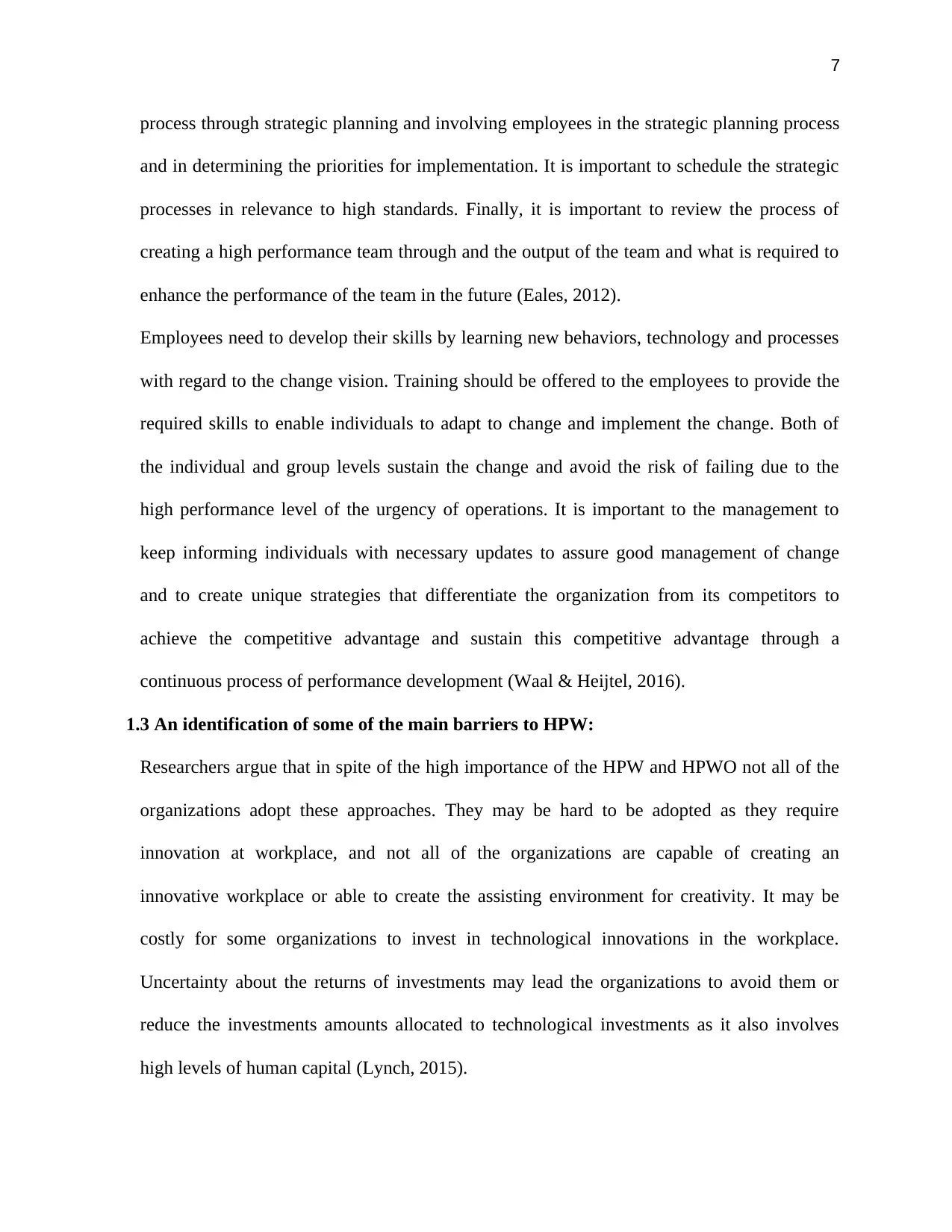
7
process through strategic planning and involving employees in the strategic planning process
and in determining the priorities for implementation. It is important to schedule the strategic
processes in relevance to high standards. Finally, it is important to review the process of
creating a high performance team through and the output of the team and what is required to
enhance the performance of the team in the future (Eales, 2012).
Employees need to develop their skills by learning new behaviors, technology and processes
with regard to the change vision. Training should be offered to the employees to provide the
required skills to enable individuals to adapt to change and implement the change. Both of
the individual and group levels sustain the change and avoid the risk of failing due to the
high performance level of the urgency of operations. It is important to the management to
keep informing individuals with necessary updates to assure good management of change
and to create unique strategies that differentiate the organization from its competitors to
achieve the competitive advantage and sustain this competitive advantage through a
continuous process of performance development (Waal & Heijtel, 2016).
1.3 An identification of some of the main barriers to HPW:
Researchers argue that in spite of the high importance of the HPW and HPWO not all of the
organizations adopt these approaches. They may be hard to be adopted as they require
innovation at workplace, and not all of the organizations are capable of creating an
innovative workplace or able to create the assisting environment for creativity. It may be
costly for some organizations to invest in technological innovations in the workplace.
Uncertainty about the returns of investments may lead the organizations to avoid them or
reduce the investments amounts allocated to technological investments as it also involves
high levels of human capital (Lynch, 2015).
process through strategic planning and involving employees in the strategic planning process
and in determining the priorities for implementation. It is important to schedule the strategic
processes in relevance to high standards. Finally, it is important to review the process of
creating a high performance team through and the output of the team and what is required to
enhance the performance of the team in the future (Eales, 2012).
Employees need to develop their skills by learning new behaviors, technology and processes
with regard to the change vision. Training should be offered to the employees to provide the
required skills to enable individuals to adapt to change and implement the change. Both of
the individual and group levels sustain the change and avoid the risk of failing due to the
high performance level of the urgency of operations. It is important to the management to
keep informing individuals with necessary updates to assure good management of change
and to create unique strategies that differentiate the organization from its competitors to
achieve the competitive advantage and sustain this competitive advantage through a
continuous process of performance development (Waal & Heijtel, 2016).
1.3 An identification of some of the main barriers to HPW:
Researchers argue that in spite of the high importance of the HPW and HPWO not all of the
organizations adopt these approaches. They may be hard to be adopted as they require
innovation at workplace, and not all of the organizations are capable of creating an
innovative workplace or able to create the assisting environment for creativity. It may be
costly for some organizations to invest in technological innovations in the workplace.
Uncertainty about the returns of investments may lead the organizations to avoid them or
reduce the investments amounts allocated to technological investments as it also involves
high levels of human capital (Lynch, 2015).
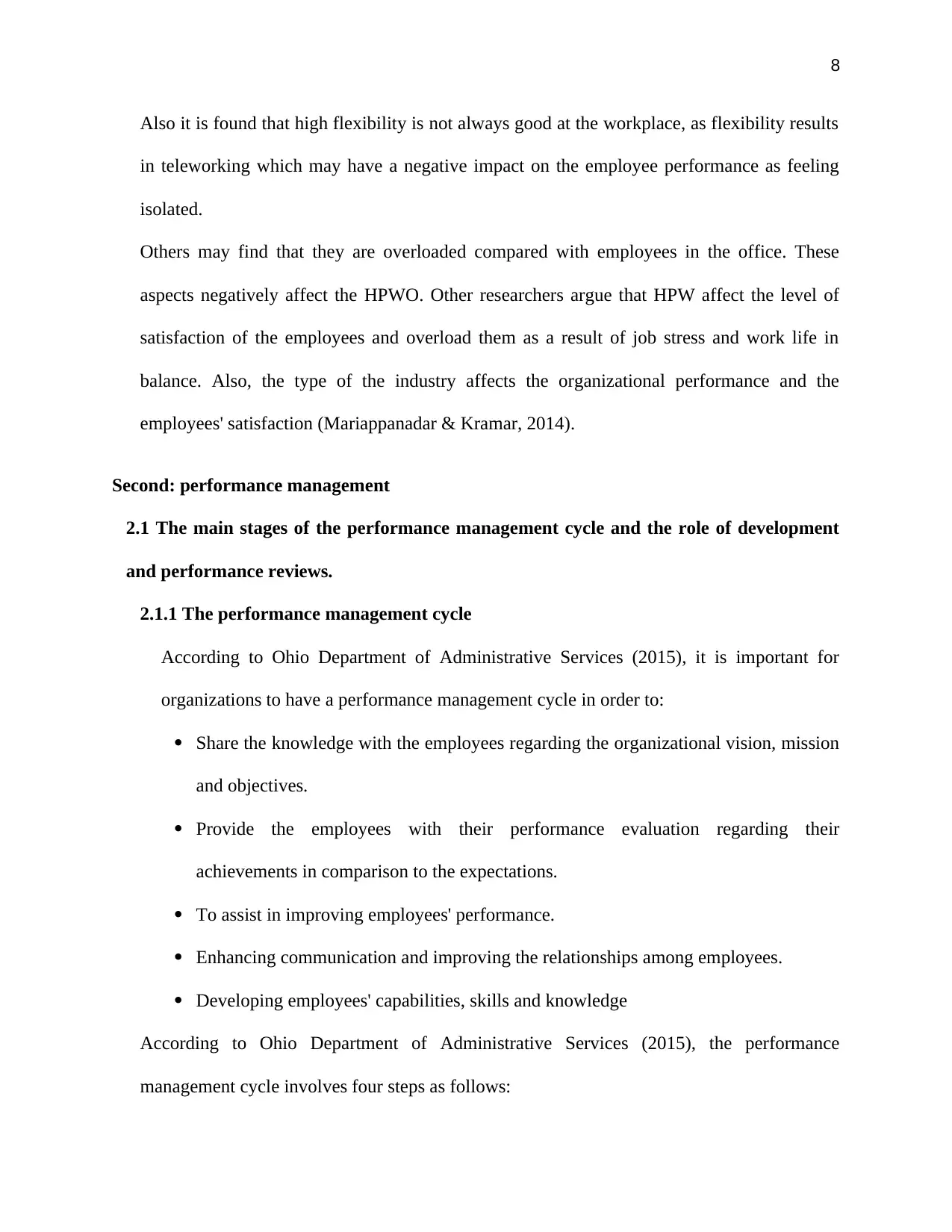
8
Also it is found that high flexibility is not always good at the workplace, as flexibility results
in teleworking which may have a negative impact on the employee performance as feeling
isolated.
Others may find that they are overloaded compared with employees in the office. These
aspects negatively affect the HPWO. Other researchers argue that HPW affect the level of
satisfaction of the employees and overload them as a result of job stress and work life in
balance. Also, the type of the industry affects the organizational performance and the
employees' satisfaction (Mariappanadar & Kramar, 2014).
Second: performance management
2.1 The main stages of the performance management cycle and the role of development
and performance reviews.
2.1.1 The performance management cycle
According to Ohio Department of Administrative Services (2015), it is important for
organizations to have a performance management cycle in order to:
Share the knowledge with the employees regarding the organizational vision, mission
and objectives.
Provide the employees with their performance evaluation regarding their
achievements in comparison to the expectations.
To assist in improving employees' performance.
Enhancing communication and improving the relationships among employees.
Developing employees' capabilities, skills and knowledge
According to Ohio Department of Administrative Services (2015), the performance
management cycle involves four steps as follows:
Also it is found that high flexibility is not always good at the workplace, as flexibility results
in teleworking which may have a negative impact on the employee performance as feeling
isolated.
Others may find that they are overloaded compared with employees in the office. These
aspects negatively affect the HPWO. Other researchers argue that HPW affect the level of
satisfaction of the employees and overload them as a result of job stress and work life in
balance. Also, the type of the industry affects the organizational performance and the
employees' satisfaction (Mariappanadar & Kramar, 2014).
Second: performance management
2.1 The main stages of the performance management cycle and the role of development
and performance reviews.
2.1.1 The performance management cycle
According to Ohio Department of Administrative Services (2015), it is important for
organizations to have a performance management cycle in order to:
Share the knowledge with the employees regarding the organizational vision, mission
and objectives.
Provide the employees with their performance evaluation regarding their
achievements in comparison to the expectations.
To assist in improving employees' performance.
Enhancing communication and improving the relationships among employees.
Developing employees' capabilities, skills and knowledge
According to Ohio Department of Administrative Services (2015), the performance
management cycle involves four steps as follows:
⊘ This is a preview!⊘
Do you want full access?
Subscribe today to unlock all pages.

Trusted by 1+ million students worldwide
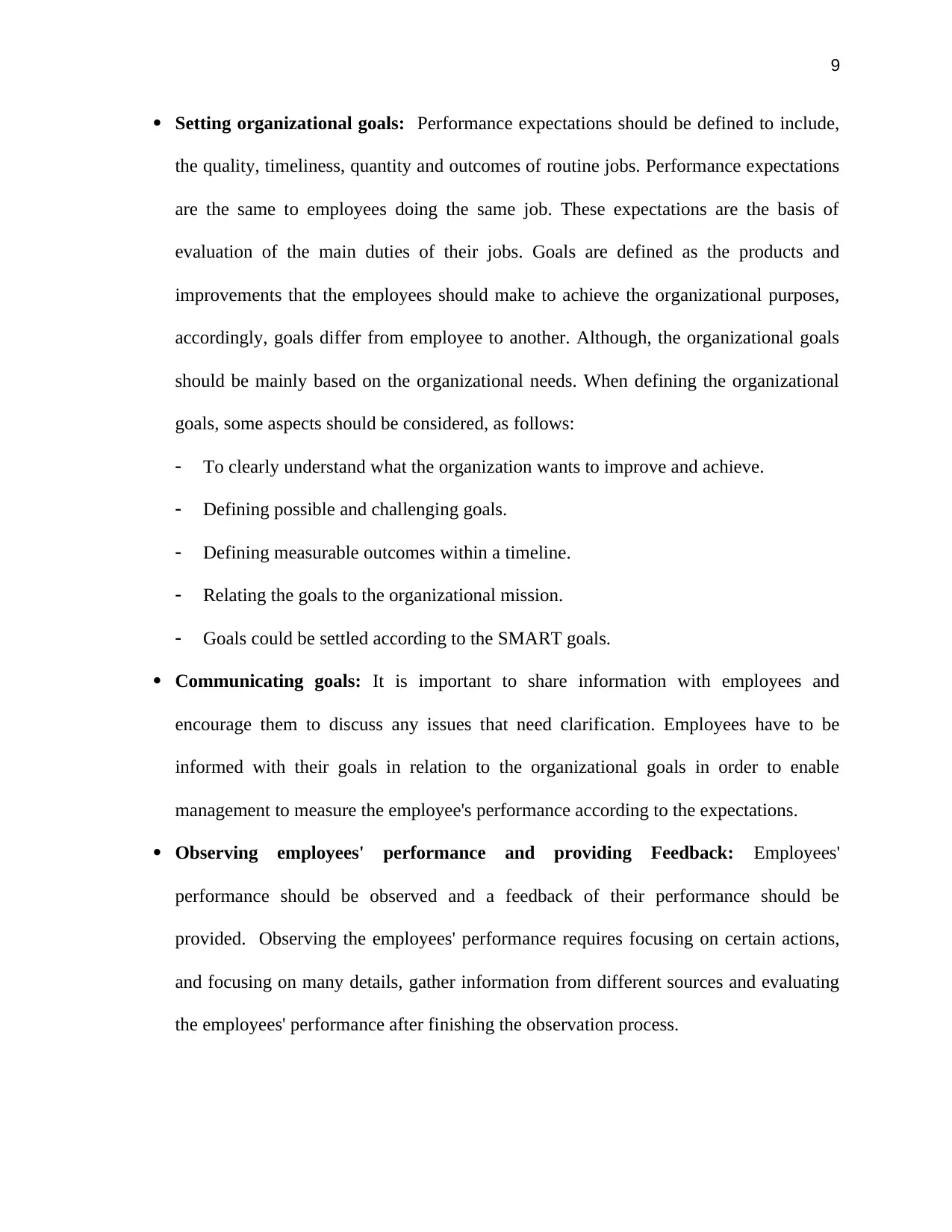
9
Setting organizational goals: Performance expectations should be defined to include,
the quality, timeliness, quantity and outcomes of routine jobs. Performance expectations
are the same to employees doing the same job. These expectations are the basis of
evaluation of the main duties of their jobs. Goals are defined as the products and
improvements that the employees should make to achieve the organizational purposes,
accordingly, goals differ from employee to another. Although, the organizational goals
should be mainly based on the organizational needs. When defining the organizational
goals, some aspects should be considered, as follows:
To clearly understand what the organization wants to improve and achieve.
Defining possible and challenging goals.
Defining measurable outcomes within a timeline.
Relating the goals to the organizational mission.
Goals could be settled according to the SMART goals.
Communicating goals: It is important to share information with employees and
encourage them to discuss any issues that need clarification. Employees have to be
informed with their goals in relation to the organizational goals in order to enable
management to measure the employee's performance according to the expectations.
Observing employees' performance and providing Feedback: Employees'
performance should be observed and a feedback of their performance should be
provided. Observing the employees' performance requires focusing on certain actions,
and focusing on many details, gather information from different sources and evaluating
the employees' performance after finishing the observation process.
Setting organizational goals: Performance expectations should be defined to include,
the quality, timeliness, quantity and outcomes of routine jobs. Performance expectations
are the same to employees doing the same job. These expectations are the basis of
evaluation of the main duties of their jobs. Goals are defined as the products and
improvements that the employees should make to achieve the organizational purposes,
accordingly, goals differ from employee to another. Although, the organizational goals
should be mainly based on the organizational needs. When defining the organizational
goals, some aspects should be considered, as follows:
To clearly understand what the organization wants to improve and achieve.
Defining possible and challenging goals.
Defining measurable outcomes within a timeline.
Relating the goals to the organizational mission.
Goals could be settled according to the SMART goals.
Communicating goals: It is important to share information with employees and
encourage them to discuss any issues that need clarification. Employees have to be
informed with their goals in relation to the organizational goals in order to enable
management to measure the employee's performance according to the expectations.
Observing employees' performance and providing Feedback: Employees'
performance should be observed and a feedback of their performance should be
provided. Observing the employees' performance requires focusing on certain actions,
and focusing on many details, gather information from different sources and evaluating
the employees' performance after finishing the observation process.
Paraphrase This Document
Need a fresh take? Get an instant paraphrase of this document with our AI Paraphraser
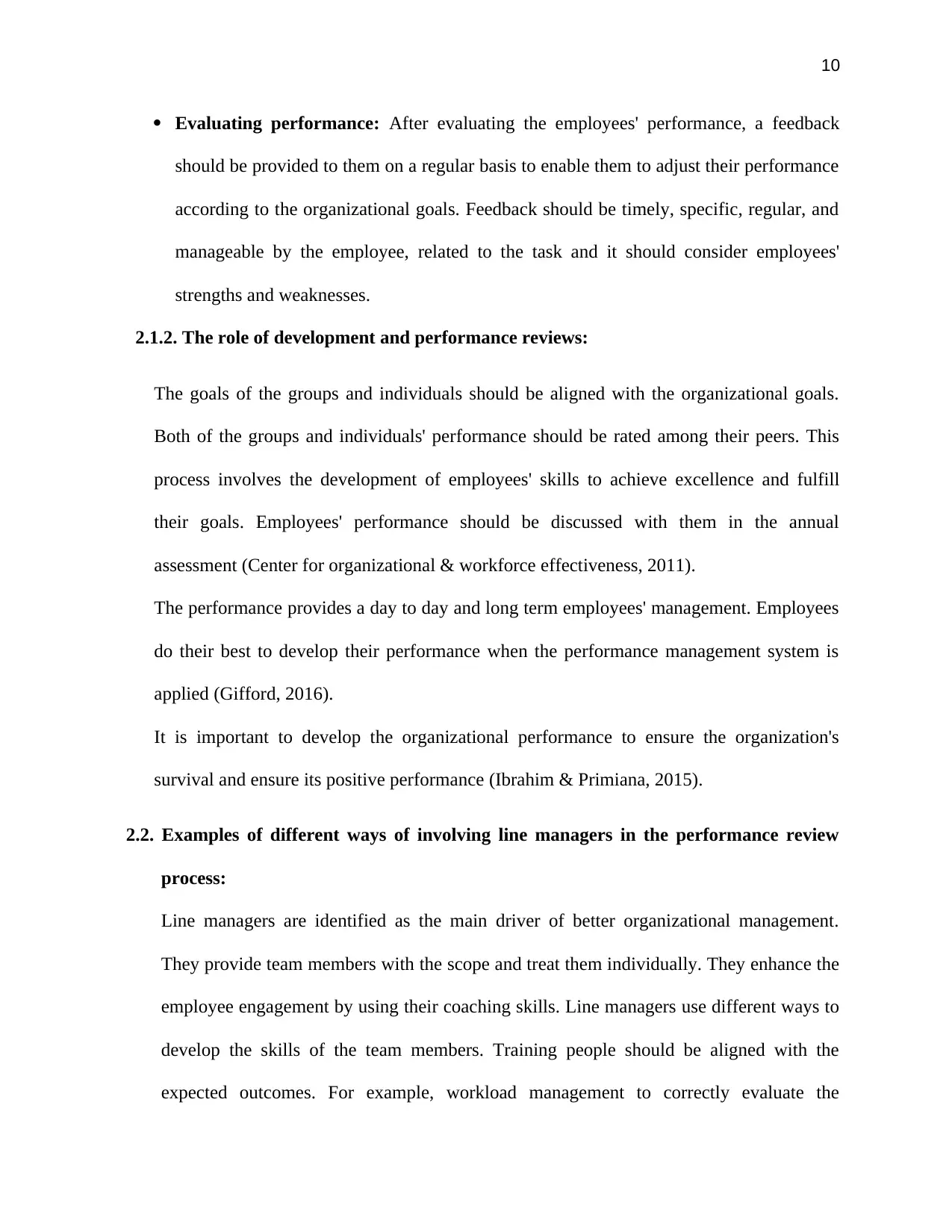
10
Evaluating performance: After evaluating the employees' performance, a feedback
should be provided to them on a regular basis to enable them to adjust their performance
according to the organizational goals. Feedback should be timely, specific, regular, and
manageable by the employee, related to the task and it should consider employees'
strengths and weaknesses.
2.1.2. The role of development and performance reviews:
The goals of the groups and individuals should be aligned with the organizational goals.
Both of the groups and individuals' performance should be rated among their peers. This
process involves the development of employees' skills to achieve excellence and fulfill
their goals. Employees' performance should be discussed with them in the annual
assessment (Center for organizational & workforce effectiveness, 2011).
The performance provides a day to day and long term employees' management. Employees
do their best to develop their performance when the performance management system is
applied (Gifford, 2016).
It is important to develop the organizational performance to ensure the organization's
survival and ensure its positive performance (Ibrahim & Primiana, 2015).
2.2. Examples of different ways of involving line managers in the performance review
process:
Line managers are identified as the main driver of better organizational management.
They provide team members with the scope and treat them individually. They enhance the
employee engagement by using their coaching skills. Line managers use different ways to
develop the skills of the team members. Training people should be aligned with the
expected outcomes. For example, workload management to correctly evaluate the
Evaluating performance: After evaluating the employees' performance, a feedback
should be provided to them on a regular basis to enable them to adjust their performance
according to the organizational goals. Feedback should be timely, specific, regular, and
manageable by the employee, related to the task and it should consider employees'
strengths and weaknesses.
2.1.2. The role of development and performance reviews:
The goals of the groups and individuals should be aligned with the organizational goals.
Both of the groups and individuals' performance should be rated among their peers. This
process involves the development of employees' skills to achieve excellence and fulfill
their goals. Employees' performance should be discussed with them in the annual
assessment (Center for organizational & workforce effectiveness, 2011).
The performance provides a day to day and long term employees' management. Employees
do their best to develop their performance when the performance management system is
applied (Gifford, 2016).
It is important to develop the organizational performance to ensure the organization's
survival and ensure its positive performance (Ibrahim & Primiana, 2015).
2.2. Examples of different ways of involving line managers in the performance review
process:
Line managers are identified as the main driver of better organizational management.
They provide team members with the scope and treat them individually. They enhance the
employee engagement by using their coaching skills. Line managers use different ways to
develop the skills of the team members. Training people should be aligned with the
expected outcomes. For example, workload management to correctly evaluate the
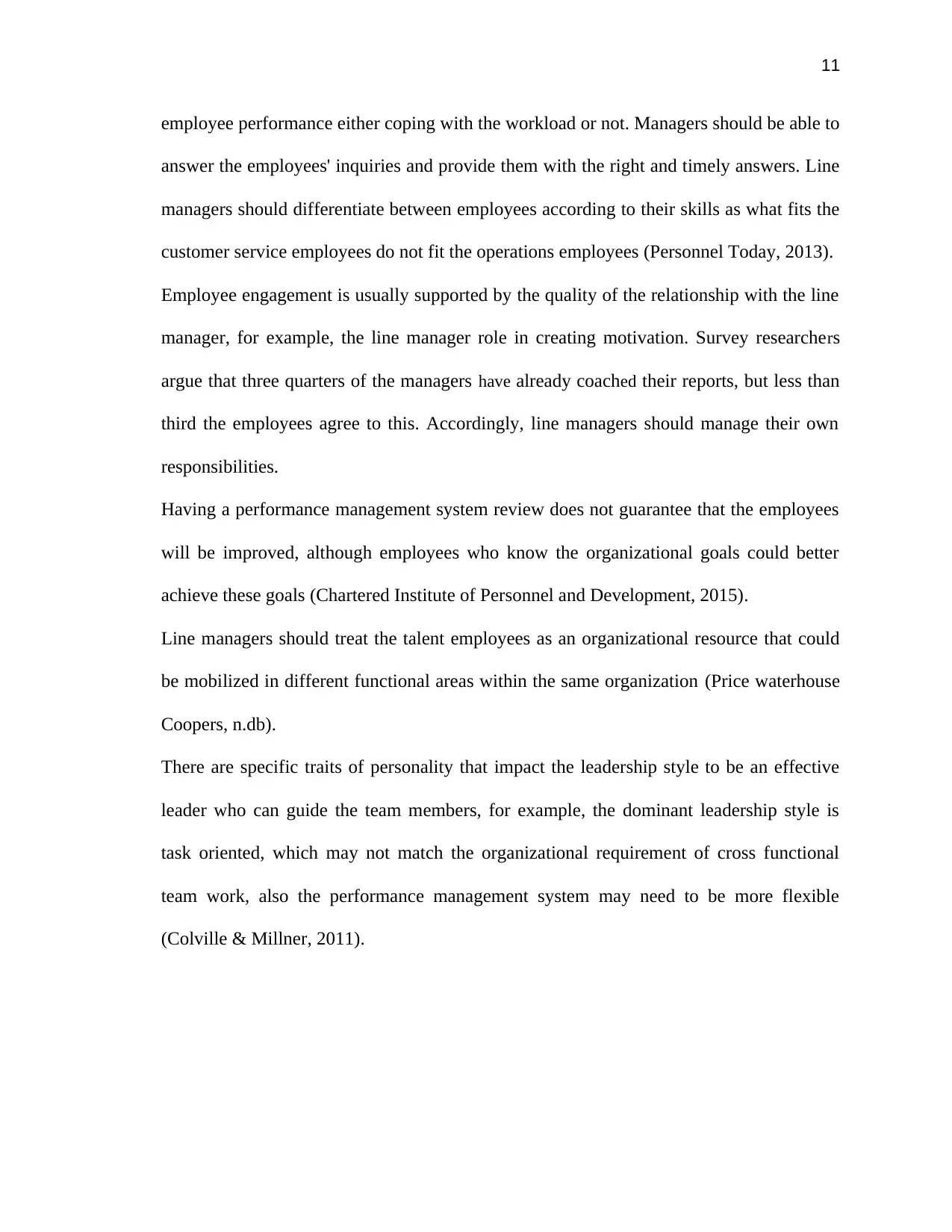
11
employee performance either coping with the workload or not. Managers should be able to
answer the employees' inquiries and provide them with the right and timely answers. Line
managers should differentiate between employees according to their skills as what fits the
customer service employees do not fit the operations employees (Personnel Today, 2013).
Employee engagement is usually supported by the quality of the relationship with the line
manager, for example, the line manager role in creating motivation. Survey researchers
argue that three quarters of the managers have already coached their reports, but less than
third the employees agree to this. Accordingly, line managers should manage their own
responsibilities.
Having a performance management system review does not guarantee that the employees
will be improved, although employees who know the organizational goals could better
achieve these goals (Chartered Institute of Personnel and Development, 2015).
Line managers should treat the talent employees as an organizational resource that could
be mobilized in different functional areas within the same organization (Price waterhouse
Coopers, n.db).
There are specific traits of personality that impact the leadership style to be an effective
leader who can guide the team members, for example, the dominant leadership style is
task oriented, which may not match the organizational requirement of cross functional
team work, also the performance management system may need to be more flexible
(Colville & Millner, 2011).
employee performance either coping with the workload or not. Managers should be able to
answer the employees' inquiries and provide them with the right and timely answers. Line
managers should differentiate between employees according to their skills as what fits the
customer service employees do not fit the operations employees (Personnel Today, 2013).
Employee engagement is usually supported by the quality of the relationship with the line
manager, for example, the line manager role in creating motivation. Survey researchers
argue that three quarters of the managers have already coached their reports, but less than
third the employees agree to this. Accordingly, line managers should manage their own
responsibilities.
Having a performance management system review does not guarantee that the employees
will be improved, although employees who know the organizational goals could better
achieve these goals (Chartered Institute of Personnel and Development, 2015).
Line managers should treat the talent employees as an organizational resource that could
be mobilized in different functional areas within the same organization (Price waterhouse
Coopers, n.db).
There are specific traits of personality that impact the leadership style to be an effective
leader who can guide the team members, for example, the dominant leadership style is
task oriented, which may not match the organizational requirement of cross functional
team work, also the performance management system may need to be more flexible
(Colville & Millner, 2011).
⊘ This is a preview!⊘
Do you want full access?
Subscribe today to unlock all pages.

Trusted by 1+ million students worldwide
1 out of 19
Related Documents
Your All-in-One AI-Powered Toolkit for Academic Success.
+13062052269
info@desklib.com
Available 24*7 on WhatsApp / Email
![[object Object]](/_next/static/media/star-bottom.7253800d.svg)
Unlock your academic potential
Copyright © 2020–2025 A2Z Services. All Rights Reserved. Developed and managed by ZUCOL.




